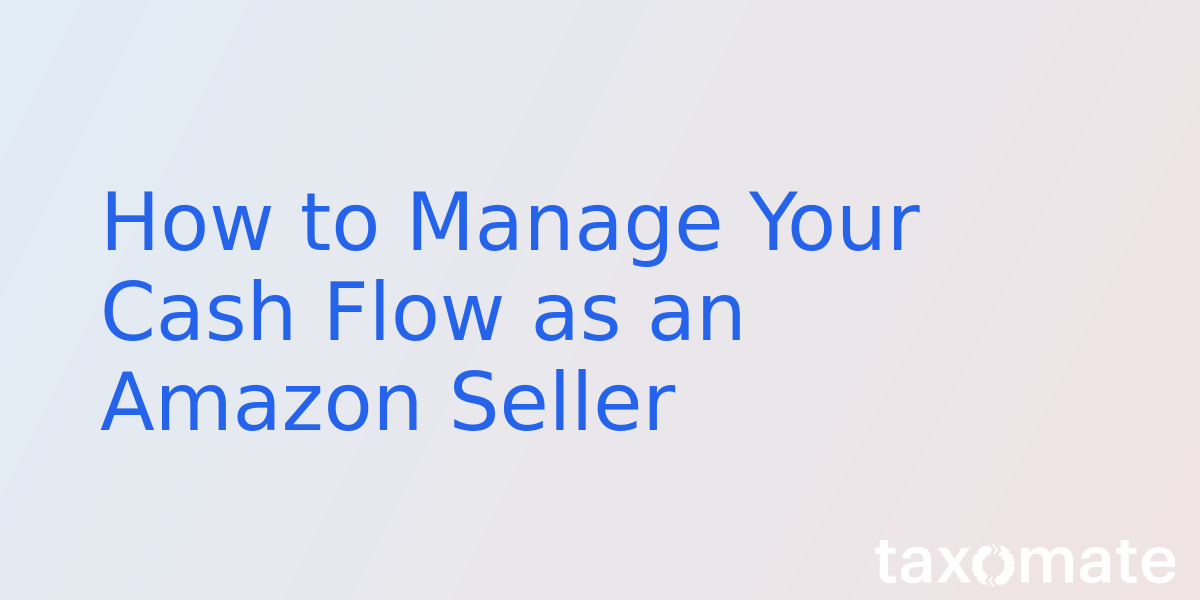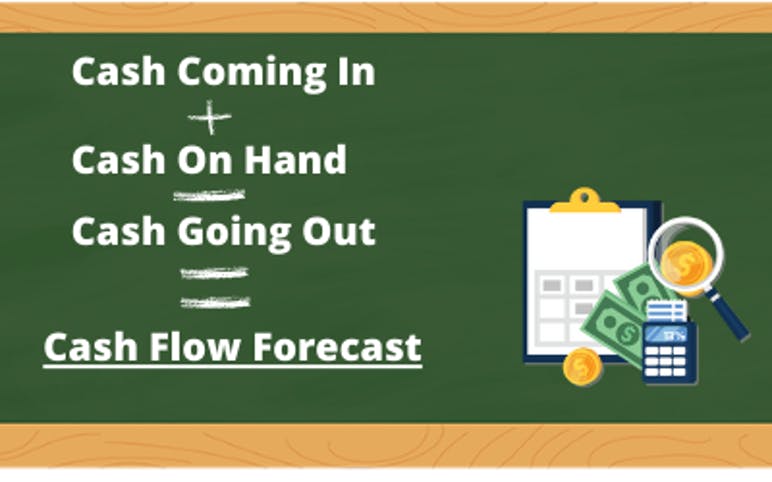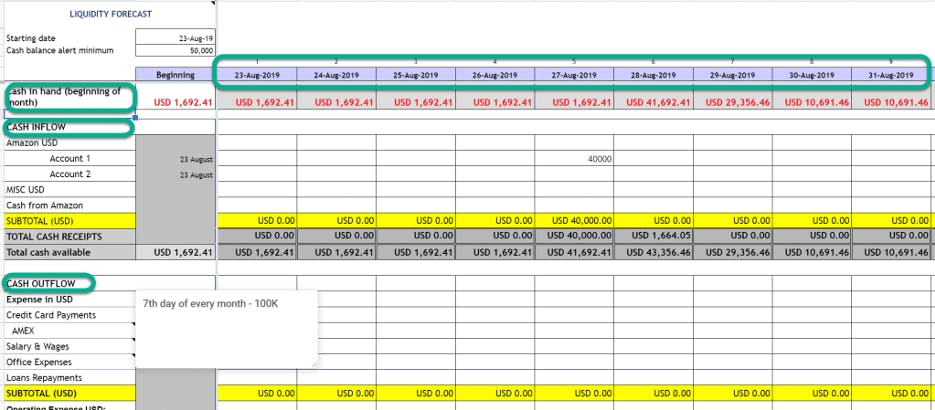
How to Manage Your Cash Flow as an Amazon Seller
![[object Object]](https://images.prismic.io/taxomate-blog/81bb9a08-f42c-4cdd-aa94-12e1e9ca63d8_Untitled.jpg?ixlib=gatsbyFP&auto=compress%2Cformat&fit=max)
Rick Wong
Do you know selling products on Amazon is a cash-intensive business? Since a lot of Amazon sellers are also first-time business operators this fine point is often lost in the conversation. Topics such as keywords ranking, reviews, and Amazon product launches normally dominate the conversion.
Don't get me wrong, these topics are important. But in order to make your Amazon business sustainable and scalable, you will need to be able to manage cash flow effectively. In this article, we will dive deep into how you can manage your cash flow as an Amazon seller.
What is Cash Flow and How is it Different from Profit?
Although your Amazon business may be quite profitable, there is a time difference between when your products are sold on Amazon and when the funds are transferred to your bank account as cash. Before we go any further, let's define profit.

Profit, then, is what occurs when money is earned rather than when it is received in cash. You can make a profit on a transaction but not receive the money until a later date, or unfortunately in some cases never.
You can't pay profit to your supplier or your staff. As an Amazon business owner, it is your responsibility to work around this problem and recognize that a significant profit does not imply a large cash balance. This is why preparing an Amazon cash flow projection is critical, as it clarifies the difference between "earnings" and "cash on hand."
What is Cash Crunch? (Not all Profits are created Equal)
Start-ups and small enterprises regularly use the term "cash crunch." A cash crunch occurs when a company runs out of cash or has a cash balance that is insufficient to satisfy its obligations. A cash crunch situation can have a significant negative influence on the company's operations.
Also want to mention that a cash crunch could also happen because not all profits are created equal. Building your Amazon business is based on strategic decisions, these decisions depend a lot on the cash coming from your business. If you cannot be sure cash is coming on a regular basis you cannot make strategic decisions to grow your Amazon business.
Examples of poor profit include:
- Profit from a very low profit margin product
- Cash conversion cycle is too long
- Unpredictability of cash coming in
If you can improve on any of the above then you will improve the quality of your profits and will stand a better chance to avoid a cash crunch.
How can you Avoid Cash Crunch as an Amazon Seller?
A cash crunch occurs when you don't have enough money on hand when you need it.
According to a 2019 study by CB Insights, 29 percent of newly founded firms fail due to a lack of funding. To avoid this, think about a few things you can do to keep your Amaon business in stock.
So how can an Amazon seller run into a cash crunch situation?
For example, to ship your order from the factory, your supplier will want the full balance of USD 30,000. You only have USD 5K on hand, and your Amazon cash balance will not be deposited into your bank account for another 7 days. You are short USD 25K in this case, and this is your cash crunch.
How can you avoid a situation like the above? You'll need to forecast your cash requirements over the following 30 to 60 days. You must forecast cash in the following buckets to construct an Amazon cash flow forecast:
- Cash coming in ➡️ For Amazon sellers, the majority of their cash will be from Amazon. The forecasting will then need to be staggered by the delay in the Amazon payouts. If you are selling on other marketplaces such as Walmart, eBay or Wish, you will forecast the cashflow coming these channels by planning their own payment delays
- Cash on Hand ➡️ This would mean any cash or cash equivalents at your disposal. Cash in the bank, personal line of credit or any liquid investments you might have
- Cash going out ➡️ This will cash to pay office rent, employee salaries and payment to suppliers.

Creating Cash Flow Forecast Step by Step
To forecast your Amazon cash flow you will just use a good old fashion spreadsheet, although there are software out there for this, but I think this would be overkill for an Amazon seller
Use a spreadsheet to plot the dates on the column, while plotting the Cash in hand, Forecast Cash Inflow, and Forecast Cash Outflow category on the row to construct this reporting.
Cash on Hand
As mentioned before these are the cash that you have available to be paid out at any time.
Forecast Cash Coming in
The majority of the inflow for Amazon sellers will come from the balance from your Amazon sales. The key will be to forecast the amount of money that will be deposited in the future.
Since Amazon maintains track of your sales for 14 calendar days, this forecast must be 14 days out. As a result, forecasting cash inflow is the first stage in building a thorough Amazon cash flow projection.
There are several methods for estimating cash inflows for your Amazon business, some of which are more difficult than others. To keep things as simple as possible, you can calculate the next Amazon cash inflow by multiplying the average of the previous two settlements by a growth rate. Let's imagine the current date is July 1, 2021. We can calculate the next Amazon payment (July 14, 2021) using the following information:
- Sales growthing 13% month over month
- Most recent payment from Amazon is $8,600
- Previous Amazon payment is $8,100
So using the above information, you can estimate the July 14, 2021 payment as:

Base on the above formula, you estimate that the Amazon payment will be $9,416 on July 14, 2021. You'll need this amount plus your existing cash-on-hand balance to fuel your operations (wage, supplier, shipping etc).
Cash Going Out
Any payment to suppliers or any current financial obligation will be a cash outflow. The following are some of the most typical uses of cash for Amazon sellers:
- Inventory payments
- Salary
- Logistics and storage
- Marketing spend (Google/Facebook ads)
In the spreadsheet, you will plot the above outflows on their due dates. This will be subtracted from your present cash balance. You have a cash crunch situation if any future date shows a negative net balance

What to do about your Cash Crunch?
There are two options, you can either slow down your growth or plug the cash crunch with external financing.
You slow down growth by increasing the price of your product. This will increase your profit margins and the frequency of inventory payments. But this is highly not recommended, especially in a highly competitive category as you can fall into the slippery slope of a negative feedback loop.
The other option would be to get external financing, but the key issue is timing, as you need to get the right amount when you need it. This is where the above cash flow forecast will come in really handy.
You might consider approaching your local bank to finance your external debt, but you'll quickly discover that they don't have the experience or process in place to finance Amazon sellers. This means long and time-consuming process to get your loans approved or if they approve you at all. As a result, there are now new Fintech companies specializing in funding Amazon sellers such as SellerFunding, Payability, and Amazon Lending.
Conclusion
Finally, Amazon sellers should carefully estimate their cash flow requirements. Although it may sound cliche, cash is the rocket fuel that propels your Amazon business forward. To avoid a cash constraint, don't be hesitant to borrow money and start looking for financing when you really need it.
![[object Object]](https://images.prismic.io/taxomate-blog/81bb9a08-f42c-4cdd-aa94-12e1e9ca63d8_Untitled.jpg?ixlib=gatsbyFP&auto=compress%2Cformat&fit=max)
Rick Wong is the founder of SellerMetrics, an Amazon PPC Software. Having worked in some of the world’s largest financial institutions in Canada, he ventured into Amazon selling in 2017 and sold his Amazon business four years later.
He currently resides in Hong Kong with his wife and 1 yr old daughter. On days that he is not in his office, you can find him playing golf with his friends or watching the newest show on Netflix with his family.